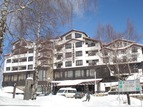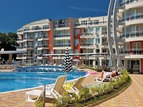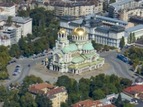Hotels in Sofia
National Natural History Museum in Sofia
Location: The National Museum of Natural History /abbreviated NMNHS/ is situated in the center of Sofia, the capital city of Bulgaria. The Sofia Art Gallery, the Ethnographical Museum, St. Alexander Nevski Cathedral, Russian Church, and the Archeological Museum are close to the National Museum of Natural History.
Address:1 Tsar Osvoboditel Blvd, 1000 Sofia, Bulgaria
Opening times:every day from 10:00—18:00, except on official holidays /1 January, 3 March and 25 December
How can I get to the museum?
Public transport:
- Subway — ‘Serdika’ stop
- Bus lines 9, 94, 280, 306 — ‘Sofia University’ stop
- Troleybus line 9 — ‘St. Alexander Nevski Square’ stop
- Troleybus lines 1, 2, 4, 11 — ‘Sofia University’ stop
- Tramway line 20 — ‘National Opera’ stop
- Tramway lines 1, 2, 7 — ‘Sveta Nedelya Square’ stop
History of the museum in brief:
The National Museum of Natural History has a history of almost one hundred and twenty years. It is the oldest museum in Bulgaria and the oldest and richest among the natural history museums on the Balkan Peninsula. It was founded in 1889 by the Royal Prince Ferdinand under the name Royal Prince’s Natural History Museum. At first it used to accommodate Prince Ferdinand’s personal collections of birds, mammals and butterflies. The first curator of the museum was the court doctor Dr Paul Leverkühn who was a famous ornithologist. He organised the first exposition in 14 halls on two floors in an old building where today’s museum stands and it was opened for visits in 1907. That year the first and until now the only full catalogue of collections was issued listing several thousand exhibits of that time.
Until WW I the museum added collections mainly from abroad, given as present or bought from famous foreign collectors and travellers. In the next decades almost all private collections of animals and plants were contributed by the first Bulgarian geologists.
The museum underwent particularly intensive development under the management of Dr Ivan Buresch, member of the Bulgarian Academy of Sciences, who run the museum from 1914 to 1959. At that time it was called the Royal Museum and laid the foundations of the Royal Natural and Scientific Institutes established in 1918. Expeditions to all Bulgarian mountains and to the neighbouring Balkan countries were organised to enrich the museum collections. Thus, many new animal and plant species were discovered. The museum turned into the main centre of studies on natural sciences in Bulgaria. Today’s four-storey building, which harbours collections from 1936, is the only building in Sofia constructed for a museum.
The museum was renamed Museum of Natural History in 1948 .
Highlight:
The visitors are intrigued by one of the last pure-bred aurochs found in nature, the brown bear proclaimed as the largest in Europe, the rare small panda, the beautiful birds of paradise, toucans, the Californian condor extinct in the wild nature, the different types of pheasants with splendid feathers, the giant African tortoise, the blind cave fish from America, the Periophtalmus fish, which can move on land as well. It is interesting to know that the National Museum of Nature and History exhibits the Caroline parrot, which became extinct worldwide, the monk seal, bearded vulture, little bustard, grey and maiden crane, steppe viper, German sturgeon, all of which extinct in Bulgaria. In recent years several dioramas were added to the exhibitions depicting the live nature of the Arctic (white bears and seals), Africa (black panther), Asia (tiger) and South American tropical forest (jaguar, ara parrots, tamarine monkeys). Other large mammals recently exhibited are the white rhinoceros, the Himalayan bear, cheetahs, buffalos.
Exhibitions:
Prior to introducing the exhibitions, please, get acquainted with one of the definitions for natural history so as to get initial notion of what you may marvel at whilst touring the interesting Museum of Natural History.
What is natural history?-Natural history is the scientific research of plants or animals, leaning more towards the observational than experimental methods of study, and encompasses mainly research.
Today, the museum offers three major sections - Geology, Zoology and Botany. The "Earth and Space" exhibition features unique lunar samples and an impressive dinosaur skeleton, as well as several meteorites. Also, there is a special exhibition, showing live pythons, crocodiles, iguanas, and many more.
Rocks, crystals and minerals grace the ground floor, while on the next two floors you can browse cases full of stuffed birds and animals, including a brown bear dangling a Nazi hunting medal from its claw and some threadbare apes, lions and tigers. Pickled fish and cases of dried insects complete the collection.
The museum exhibitions occupy 16 halls on four floors.
- Floor 1: Non-living nature
Floor 1 acquaints visitors with the non-living nature. Here you can learn about the variety of rocks and minerals.
- Floor 2: The diversity of living nature
The acquaintance with the richness of the living nature starts on the second floor- the Fossil Animals and Plants Hall, the Fishes and Amphibians Hall, the Reptiles Hall, and the Birds Halls.
- Floor 3: Mammals
The third floor shows the diversity of recent mammals.
- Floor 4: The Invertebrates
The fourth floor acquaints visitors with the infinite diversity of the invertebrates: the Insect exposition and the Non-insect Invertebrates Hall. On the same floor, plants are presented as well.
There is also a permanent exhibition of live animals, mainly exotic reptiles and amphibians.
National Museum of Nature and History is the only national institution directly engaged with the preservation of scientific collections of live and non-live nature from Bulgaria and the world. The study of biodiversity, environmental protection and the evolution of organisms are the museum’s major priorities.
Official website of National Museum of Nature and History
Bulgarian Natural History Museum on the map of Sofia
Other museums in Sofia
Hotels in Sofia





- Anel Hotel
- Arena di Serdika Boutique Hotel
- Grand Hotel Sofia
- Hilton Sofia Hotel
- Holiday Inn hotel
- Hyatt Regency Sofia Hotel
- Intercontinental Sofia (ex Radisson Blu Grand Hotel)
- Sofia Hotel Balkan a Luxury Collection Hotel (ex Sheraton Hotel)




- Best Western Hotel Europe
- Best Western Premier Sofia Airport
- Central Hotel
- City Hotel
- Crystal Palace Hotel
- Downtown Hotel
- Festa Sofia Hotel
- Geneva Hotel
- Gloria Palace Hotel
- Hill Hotel
- Hotel Coop
- Les Fleurs Hotel
- Metropolitan hotel
- Novotel Sofia
- Ramada by Wyndham Sofia City Center
- Rodina Hotel
- Rosslyn Central Park Hotel
- Rosslyn Thracia Hotel
- Salt Palace Hotel
- Sveta Sofia Hotel
- The Stay Hotel Expo Center
- VEGA Hotel Sofia
- Vitosha Park Hotel



- Akord Hotel
- Aleksander Palace - Advi
- Arte Hotel
- Best Western Losenets Hotel
- Best Western Plus Bristol
- Brod Hotel
- Budapest hotel
- Earth and People hotel
- Hemus Hotel
- Legends hotel
- Light hotel
- Lion Hotel
- Maxim Hotel
- Meg-Lozenets Hotel
- Montecito Hotel
- Park Hotel Moskva
- Rocentro /ex Renaissance Hotel/
- Slavyanska Beseda Hotel
- Sofia Place Hotel


- Medic Hotel
Upcoming events in Sofia
- Sofia Dance Week 2010
- Art festival in Sofia city
- Scorpions in Sofia city 2010
- International Feline Show in Sofia
- Paco De Lucia performs in Bulgaria
- Drumset Competition 2010- Sofia Drum Day
- TOP 100 DJs party Monarchy performs in Bulgaria
- Chris Norman performs in Bulgaria 2010
- Harlem Gospel Choir performs in Bulgara
- Yann Tiersen's concert for Students Holiday
- Disco Legends Boney M concert in Bulgaria
- Legendary Firewind performs in Sofia
- Barclay James Harvest performs in Bulgaria
- Vaya Con Dios in Bulgaria
- 15th Sofia International Film Festival
- Absent Minded
- Concert of the queen of fado Marisa in Sofia, Bulgaria
- Guano Apes in Bulgaria
- Toto Cutugno in Bulgaria
- Manu Chao in Sofia city
- Children of Bodom in Bulgaria
- Alphaville in Sofia
- Rosalia de Souza in Bulgaria
- Vassil Vassilev and Chambao
- 100 Gypsy Violins in Bulgaria
- Raul Midon in Bulgaria
- Omega- the most successful Hungarian Rock Band gigs in Bulgaria
- Joe Cocker
- Roxette in Sofia, Bulgaria 2011
- Isthar in Sofia city
- Sting in Bulgaria
- CINDERELLA & MR.BIG in Bulgaria
- Dragana Mircovich and Vesna Zmijanac gig in Bulgaria
- Michel Legrand in Bulgaria
- Linkin Park in Bulgaria
- Mellow Music Festival
- Omara Portuondo and Buena Vista Social Club in Bulgaria
- ARASH feat. Rebecca concert in Bulgaria
- Mor Karbasi’s concert in Bulgaria
- Alice Russel in Sofia city
- Gipsy Kings gig in Bulgaria
- Jean Michel Jarre in Bulgaria
- Eric Sardinas concert
- Pooh gigs in Bulgaria
- Manhattan Transfer's concert in Bulgaria
- Hindi Zahra’s concert in Bulgaria
- Amon Amarth concert in Bulgaria
- Sade gigs in Bulgaria in November
- Genesis gigs in Bulgaria
- Julio Iglesias concert
- Sofia Rocks festival 2012
- Jennifer Lopez- concert in Bulgaria
- Depeche Mode performs in Bulgaria in May 2013
Places to go in Sofia
- St. Alexander Nevski Cathedral
- Boyana Church
- National Museum of History
- Alexander Nevsky Crypt Icon museum
- Vitosha Nature Park
- “Ivan Vazov” National Theatre
- The St. Petka Samardjiska Church /St. Petka of the Saddlers/
- Borisova Gradina Park (Central Park)
- Bulgarian National Gallery for Foreign Art
- St. George Rotunda-the oldest Eastern European Orthodox church
- Bulgarian National Gallery of Arts
- National Archaeological Museum
- Fountains in Sofia
- Public gardens and green areas
- St. Sofia church- ancient Eastern Orthodox church in Sofia
- St. Nikolay Russian church
- Sofia botanical garden
- Church of the Holy Seven
- Sofia Zoo
- Bulgarian Natural History Museum
- Sofia City Art Gallery
- Pancharevo lake
- Ethnographic Museum
- St. Nedelya church
- Museum of Earth and Man
- Sofia University Botanic Garden
- Cathedral of St Joseph
- Independence Square
- Boyana waterfall
- Alexander Nevski Square
- King Alexander Battenberg Square
- National Assembly's building in Sofia
- Tsar Osvoboditel Boulevard
- Vitosha Boulevard
- St. Paraskeva Church
- Eagle's Bridge
- Atanas Burov Square
- St. 40 Martyrs Church
- Oborishte street
- Rila monastery
- Slaveikov square
- National Palace of Culture
- National Library St. St. Cyril and Metodius
- Banya Bashi Mosque
- Jewish synagogue in Sofia
- Lion's bridge
- Law Courts
Deals & discounts in Sofia
News from Sofia
- Bulgaria’s National history museum included in the EU project “Museums present Europe”
- International Festival of the Masquerade Games in Pernik town, Bulgaria
- Ice Bar in Sofia city
- Burgas, Varna, Sofia – included in 100 Global Cities Destination Ranking
- Skiing in Vitosha mountain
- Sofia hotels in top 10 capital cities worldwide
- Festival “Skiing and snowboarding in the city” is held in Sofia
- Days of challenges in Sofia city
- Bon Jovi visits Bulgaria in 2013
- No restored ski equipment at Vitosha Mountain
- New cultural and historic route Sveta Gora
- International kids folklore festival in Sofia city
- Low cost flights from Sofia airport to Budapest
- Ski competition at Vetrovala in Vitosha Mountain today
- 16th International Sofia Movie festival
- Sofia is the cheapest holiday destination in Europe
- Christmas traditions will be presented in Ethnographic museum in Sofia
- Central Mineral bath in Sofia becomes a museum and SPA centre
- Sofia is the cheapest holiday destination in Europe
- 3 Airline Carriers Stop Winter Flights to Sofia
- A growth of 6,6% of passengers at Sofia airport
- Tourist information centre opened at Sofia Airport
- Gipsy Kings performance is postponed
- French Movie Festival in Sofia city
- Cheapest hotels in Sofia city
 Member of:
Member of:



































































 Touroperator
Touroperator
